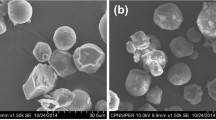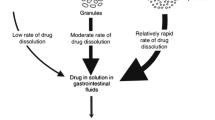Abstract
A novel form of cellulose powder was evaluated as a filler-binder in tablets. The particle, powder, flow and binding properties of this experimental cellulose material were compared with those of two commercial microcrystalline celluloses, Avicel® PH 101 and Emcocel®. The effect of various storage conditions on the physical stability of tablets compressed from celluloses was also evaluated. The particle size and shape of experimental cellulose powder differed markedly from those of microcrystalline celluloses. Experimental cellulose contained mainly large and roughly spherical agglomerates of particles, among which were few smaller regularly shaped particles. Because of spherical particle shape, the experimental cellulose powder flowed better than microcrystalline celluloses, which consisted of much more irregularly shaped particles. Experimental cellulose formed stronger tablets than microcrystalline celluloses. It also acted more effectively than microcrystalline celluloses as a binding material in tablets containing poorly compressible ascorbic acid and acetaminophenone. This may be due to the extensive surface area of the particles of experimental cellulose powder. The specific surface area of this material was over 50 times as great as that of microcrystalline celluloses. This indicates an extremely porous structure of cellulose agglomerates. Tablets containing experimental cellulose powder were able to resist a permanent loss in tablet strength at different storage conditions better than tablets containing microcrystalline celluloses. According to the results of this study an experimental agglomerated form of cellulose powder is a very advantageous material as a filler-binder for direct compression of tablets.
Similar content being viewed by others
References
Doelker E, Garny R, Schurz J, Janosi A, Matin N. Degrees of crystallinity and polymerization of modified cellulose powders for direct tabletting. Powder Technol 1987;52:207–13.
Bolhuis GK, Lerk CF. Comparative evaluation of excipients for direct compression. I. Pharm Weekbl 1973;108:469–81.
Lerk CF, Bolhuis GK, De Boer AH. Effect of microcrystalline cellulose on liquid penetration in and disintegration of directly compressed tablets. J Pharm Sci 1979;68:205–11.
Paronen P. Xylan as a direct compression adjuvant for tablets. Kuopio: University of Kuopio, 1983. Dissertation.
Rudnic EM, Chilamkurti R, Rhodes CT. Further studies of the potential of recording powder flow meters. Drug Dev Ind Pharm 1980;6:279–89.
Doelker E, Mordier D, Iten H, Humbert-Droz P. Comparative tabletting properties of sixteen microcrystalline celluloses. 6th Pharmaceutical technology conference, Canterbury, England, 1987. Conference Proceedings. 1987;III:115–44.
Allen T. Particle size, shape and distribution. In: Particle size measurements. London: Chapman and Hall Ltd., 1978:80.
Neumann BS. Bean HS, Beckett AH, Carless JE, eds. Advances in pharmaceutical sciences. Vol 2. London: Academic Press, 1976:181.
Juslin M, Kahela P, Paronen P, Turakka L. Comparative evaluation of starches as tablet adjuvants. Acta Pharm Fenn 1981;90:83–93.
Kawakita K, Ludde KH. Some considerations on powder compression equations. Powder Technol 1970/71;4:61–8.
Yamashiro M, Yuasa Y, Kawakita K. An experimental study on the relationship between compressibility, fluidity and cohesion of powder solids at small tapping numbers. Powder Technol 1983;34:225–31.
Zografi G, Kontny MJ, Yang AYS, Brenner GS. Surface area and water vapor sorption of microcrystalline cellulose. Int J Pharm 1984;18:99–116.
Carstensen JT. Theory of pharmaceutical systems. Vol. II. Heterogeneous systems. New York: Academic Press, 1973:187.
Fox CD, Richman MD, Reier GE, Schangraw R. Microcrystalline cellulose in tabletting. Drug Cosm Ind 1963;92:161–4, 258–61.
Chowan ZT, Palagyi L. Hardness increase induced by partial moisture loss in compressed tablets and its effect onin vitro dissolution. J Pharm Sci 1978;67:1385–9.
Author information
Authors and Affiliations
Rights and permissions
About this article
Cite this article
Pesonen, T., Paronen, P. & Puurunen, T. Evaluation of a novel cellulose powder as a filler-binder for direct compression of tablets. Pharmaceutisch Weekblad Scientific Edition 11, 13–19 (1989). https://doi.org/10.1007/BF01972909
Received:
Revised:
Accepted:
Issue Date:
DOI: https://doi.org/10.1007/BF01972909




